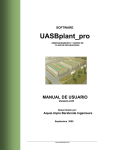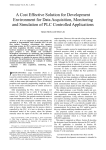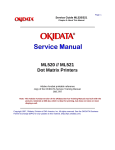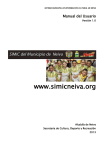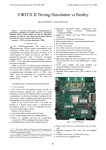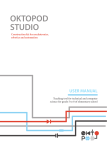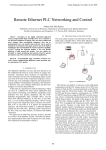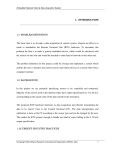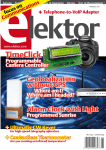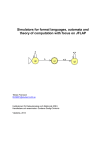Download system for automatic measurement of signal level in gsm 900
Transcript
SYSTEM FOR AUTOMATIC MEASUREMENT OF SIGNAL LEVEL IN GSM 900/1800 CHANNEL WITH GPS LOCALIZATION Dusan Radovic1, Mirjana Simic2 1Institute ”Michael Pupin“, Belgrade, [email protected] 2Faculty of Electrical Engineering, Belgrade, [email protected] I INTRODUCTION For reliable mobile communications received signal level must be above the receiver sensitivity. Determining of zone in which this requirement is satisfied is done in the phase of planning of mobile system by the various methods of electrical field prediction. Calculated values, and the methods itself, are verified by checking in the field. Measurement systems made only for this purpose are fast, autonomous, and very expensive. In Global System for Mobile communications (GSM) mobile phones measure signal level received from base station. The main idea of this work is to read-out signal level from the phone and concurrently collects geographical coordinates of measuring location. Combining data of signal level with location coordinates transmitter coverage area can be presented on a digital map [1]. There is previous work [2], [3] related to this coverage determination problem. We expanded the choice of solutions by our system that measures signal in any of GSM channels. The system can be used for checking GSM test transmitter coverage area or coverage of real base station transmitter. The same configuration can be used for measurement of noise and interference levels in any of the GSM channels that are not used. In the following section measurement system is presented. Part III explains results of measurement. Section IV is dedicated for performance analysis and comparison with existing solutions. At the end conclusion and abstract are given. II MEASUREMENT SYSTEM This section explains architecture of measurement system and gives block diagram and front panel of measurement software. Basic system configuration comprises laptop computer, mobile phone and GPS (Global Positioning System) receiver as shown in figure 1. It is possible to add external antenna for phone and for GPS. Additional power supply may be provided for all parts for longer measurements. Supported phone models are from Nokia 61xx and 51xx series. GPS receiver is Garmin II PLUS [4] or any other that supports NMEA 0183 protocol [5]. First version of system was using MBUS protocol [6] for communication with phone, which is on 9600 bit/s. In that version we had ten readings in one second. Current version uses protocol FBUS [6], because it enables faster data transfer than older MBUS. By this protocol (and speed) change, we obtained more than twofold decrease of one measurement period. One could expect much more but the limiting factor is in our phone that can send new signal level every 35ms. Laptop computer Mobile phone FBUS 115200 8N1 NMEA 4800 8N1 GPS receiver Figure 1. Main components of measurement system. Communication between computer and phone and GPS is achieved through serial (RS232) connection. With Nokia 6110 mobile phone it is used FBUS protocol, speed of 115200 bit/s and 8data bits, no parity bit and one stop bit. GPS receiver Garmin II PLUS uses NMEA 0183 protocol, speed of 4800 bit/s, no parity bit and one stop bit. Measurement software, a Windows application written in LabVIEW package [7], controls all system parts and configures the entire system. Communication with phone is based on sequences of: - request from measurement software, - acknowledge of request reception by phone, - answer from phone and - acknowledge of the answer reception by software. Diagram of measurement process is shown in figure 2. Phone is first initialized in a so-called local mode that enables setting RF channel and reading signal level values. Reading of is done in a while loop. After sending request, measurement software waits until answer from phone comes, then process it, displays value and writes to file. On front panel, given in figure 3, default values of various control parameters are given. Operator can change them all before the measurement is started. Number of samples until measurement is ended and some others is possible to change during the measurement. Port numbers for peripherals can’t be the same. GSM channel number in which measurement is to be performed is chosen. In addition, identification on location of measurement and operator are written. Minimal level of signal is set too. It can be chosen to do time-triggered measurement with and without GPS localization. START Check the apparatus Yes Problem? No Read-out and check data from phone and GPS No Problem? packet is 700 bytes long and can be transferred in about one second, which is performed in consecutive readings, in time slots when waiting answer from phone. For each frame is checked validity of location data because three or more satellites are needed for reliable position fix. From directly measured signal power level electrical field level can be found by formula (1). Additive factor is dependent on frequency, antenna gain and cable loss and for GSM measurements it is about 140 dB. Yes E [dBµV / m] = P [dBmW ] + Add . factor [dB] (1) Operator should put appropriate value for additive factor in front panel and measured values would be converted to electrical field level, shown on graph, and put in file. III RESULTS Write data to output files No Communication with operator End? Yes END Figure 2. Simplified block diagram of the measurement process controled by software. Communication with GPS is simpler. Computer listens on GPS port and reads data. According to NMEA format data are divided, by GPS, in frames which are generated every two seconds. Each frame consists of 12 subframes in which are contained many information for user. All measured values are saved in two output files in ASCII form suitable for further manipulation. In file *.mob signal level in GSM channel is written, and in *.gps geographical coordinates of measurement points, where “*” denotes the same file name chosen by user. The correlation of two files is explained in figures 4 and 5. In both files header and footer gives basic information of concrete measurement. If the position data are not available in *.gps file is written text “No satellites!”. File name: Date [mm/dd/yy]: Location: Operator: Measurement started at: GSM channel number: Minimal level [dBm]: Additive factor [dB]: measure83.mob 10/23/02 test location test operator 06:29:46 PM 83 -102.0 0.00 Sample Value 1 -54.5 2 -54.4 3 -54.1 4 -54.3 5 -54.6 …………….... 29996 -53.3 29997 -53.6 29998 -53.1 29999 -53.3 30000 -53.2 Figure 3. Front panel of measurement software during the testing with real GSM signal and simulated GPS position. It is easy to use and very flexible for various computer configurations. We have used first subframe GPRMC (GPS and Transit Specific) from which localization data are extracted. Whole Date [mm/dd/yy]: Measurement ended at: Average meas. period [ms]: 10/23/02 06:55:01 PM 49.89 Figure 4. Start and end of output file measure83.mob with signal level values in 83rd GSM channel. Note that average measurement period is near 50ms. A case where valid data from GPS receiver is not available is rarely found. Possible loss of location data is in urban areas with many tall buildings. File name: GPS position correction: measure83.gps latitude 0" longitude +20" 10/23/02 06:29:46 PM longitude Date [mm/dd/yy]: Measurement started at: latitude GPS mob 1 40 45ø00'00.0"N 019ø41'35.0"E 2 80 45ø00'00.0"N 019ø41'35.0"E 3 120 45ø00'00.0"N 019ø41'35.0"E 4 160 45ø00'00.0"N 019ø41'35.0"E 5 199 45ø00'00.0"N 019ø41'35.0"E ................................................................................ 767 29802 45ø00'00.0"N 019ø41'35.0"E 768 29842 45ø00'00.0"N 019ø41'35.0"E 769 29881 45ø00'00.0"N 019ø41'35.0"E 770 29921 45ø00'00.0"N 019ø41'35.0"E 771 29961 45ø00'00.0"N 019ø41'35.0"E Date [mm/dd/yy]: 10/23/02 Measurement ended at: 06:55:01 PM Figure 5. Output file measure83.gps with latitude and longitude values paired with signal level measurements from file measure83.mob (number in second column). Localization data are same because GPS is in simulation mode. IV PERFORMANCE ANALYSIS Minimal period of measurement of GSM signal level can be adjusted to less than 50ms and depends on computer configuration. Coordinates from GPS receiver are obtained on every 2 second. If the vehicle has speed of 20m/s (72km/h), the minimal distance between successive measurements of GSM signal is less than 1m and between two successively read positions is about 40m. For older computers average measurement time is increasing if graph is displayed on the screen and if sound signalizes lower level than settled limit. For this reasons it is possible to switch off both during measurement. Mobile phone does not have measurement speed of TS55-C3 (Table 1.), but has smaller dimensions and mass. Measurement accuracy of system, inherited from phone, is better than 1dB, which is like in TS55-C3. Calibration can be achieved by procedure given in service manual for cellular phone [8]. Table 1. Comparison of solutions for GSM signal measurement by minimal measurement time and frequency band. Our Anritsu Rohde & system ML521 A/B Schwarz TS55C3 Minimal < 50ms 50ms 3ms meas. time Band GSM 25MHz to GSM 900/1800 900/1800 1000MHz V CONCLUSIONS Measurement system presented in this paper is realized on idea of effective signal level measurement in chosen GSM channel and testing transmitter coverage by using available and simple measurement equipment. Using mobile phone as receiving unit it can be avoided use of complex measurement receiver and signal level is detected by the very same receiver the user has. Collecting geographic coordinates from GPS enables coverage zone identification on digital map. During the testing in laboratory system has shown expected reliability. Presented system is more flexible and cheaper in comparison with special ones but with higher measurement period. As system speed is limited by phone further work should be on speeding up measurement by using other series of Nokia mobile phones. In addition, support for simultaneous measurement on two or three mobiles (channels) may be added, which is limited by number of serial ports on computer. REFERENCES [1] Gordana Zivanovic, Aleksandar Neskovic, Natasha Neskovic, George Paunovic, Processing and Graphical Presentation of GSM Signal Level Measurements, TELFOR 2000, Belgrade [2] Mirjana Simic, Rastko Zivanovic, Aleksandar Neskovic, George Paunovic, System for Automatic Electric Field Level Measurements with GPS Localization, TELFOR 2000, Belgrade [3] Rastko Zivanovic, Mirjana Simic, Aleksandar Neskovic, George Paunovic, Automated System for GSM Signal Level Measurement Using GPS Localization, TELFOR 2000, Belgrade [4] GPS II PLUS, Owner's Manual & Reference, GARMIN Corporation, 1997 [5] NMEA 0183 Interface Standard, Version 2.30, National Marine Electronics Association, 1998 [6] FBUS and MBUS protocol, http://www.gnokii.org [7] LabVIEW User Manual, National Instruments, 1998 [8] Service manual for NOKIA cellular phones Acknowledgement: Measurement system is realized at Laboratory for radio-systems, Telecommunication department, Faculty of Electrical Engineering in Belgrade. Abstract: Main goal of this paper is presentation of a mobile, flexible and economical solution of automated system for measurement of signal level in chosen GSM 900/1800 channel. Measurement system comprises cellular phone and satellite radio-navigation system receiver connected to laptop computer. Full automatization of the measurement process is achieved by software, implemented in LabVIEW software package that controls and manages the system. Accuracy of measured signal level is better than 1dB and measurement period is less than 50ms. System is suitable for fieldwork and can be used in testing coverage of transmitter or when checking interference levels. Comparison of our solution with existing solutions is also given.






